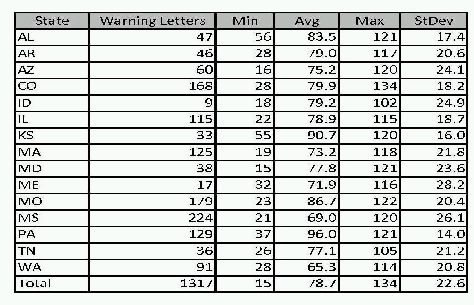Welcome to the next monthly installment in FDA's enforcement of regulated tobacco products. This month we will examine some of the differences found between different states in FDA enforcement actions against retailers.
- Sheppard Mullin has been closely monitoring FDA's tobacco enforcement actions to better serve its clients. From the beginning of FDA's program inspecting tobacco retailers, a trend emerged suggesting that there are significant differences in enforcement between retailers depending on the state in which the inspection was conducted. This raises concerns about not only in how each state conducts its retail inspection program, but the level of oversight applied by the Center for Tobacco Control over the program as a whole.
One of the most important of these state-to-state differences relates to the percentage of inspections resulting in an enforcement action. The following table provides the most recent data for states where more than 1,000 retailer inspections were conducted.
|
State |
Inspections |
Enforcement Action Rate |
Civil Money Penalties |
|
MO |
2,235 |
13.65% |
0 |
|
IL |
1,214 |
13.18% |
0 |
|
CO |
2,125 |
11.11% |
7 |
|
AZ |
1,251 |
8.07% |
1 |
|
WA |
1,644 |
7.42% |
4 |
|
MS |
4,976 |
6.95% |
10 |
|
AR |
1,541 |
5.58% |
0 |
|
All1 |
40,001 |
5.07% |
29 |
|
MA |
3,892 |
4.39% |
5 |
|
TN |
1,342 |
4.32% |
0 |
|
MD |
2,294 |
3.05% |
1 |
|
PA |
5,883 |
3.04% |
0 |
|
AL |
3,221 |
2.64% |
1 |
|
KS |
2,687 |
2.01% |
0 |
|
ME |
4,203 |
0.74% |
0 |
As demonstrated by the table, the rates across the different states vary by a broad margin. For states where more than 1,000 inspections have been conducted, the highest state action rate is well over 10% greater than the lowest state action rate. In statistical terms, enforcement action rates for four (4) of these fourteen (14) states fall outside of the standard deviation for the set.2
- The difference in enforcement action rate may be due to any number of causes. The most critical issue is whether the difference is the result of factors that are within FDA's control, or the result of factors outside of FDA's control. For example, a particular state government's bias for or against tobacco retailing in general may have a significant influence on that state's enforcement action rate. This would be a factor controllable by FDA through the administration and management of state retail inspection contracts.
Not every factor is within FDA's power to control. For example, a state may have lacked laws or regulations governing tobacco retailing prior to the enactment of the Family Smoking Prevention and Tobacco Control Act (Tobacco Control Act), or may have lacked funding to enforce such laws or regulations. Alternatively, a state may have had a very strict regulatory regime with robust enforcement prior to enactment.
There is reason to believe that the difference in enforcement action rate is due to factors within FDA's control. Most telling are the state-by-state differences in the length of time from inspection to Warning Letter issuance. A wide variation across different states suggests that FDA's management of the inspection program has a significant impact on many aspects of the program, including enforcement.
A lengthy delay between a retailer's inspection and the issuance of a Warning Letter is a common occurrence, which leads to a lack of notice to retailers who wish to act responsibly. As of January 20, 2012, the average length of time between inspection of a tobacco retail facility and the subsequent issuance of a Warning Letter was over seventy (78) days. The following table displays the minimum, maximum, and average number of days from inspection to Warning Letter, by state, as well as the standard deviation.3

This data is represented graphically in the following chart. The red I-bars represent one standard deviation from the average.

Figure 1
On average, a retailer can expect to wait eleven (11) full weeks from the date of an inspection before a Warning Letter is sent. In many instances, a retailer first learns that an inspection has occurred when the Warning Letter is received. Of course such lengthy delays make it nearly impossible for a retailer to effectively evaluate the situation, and adequately address any alleged violations.
Maintaining consistency in enforcement has long been a struggle of the agency in other areas. While it is not surprising to see these issues arise in the context of tobacco retailer enforcement, it is discouraging given the centralized nature of FDA's management over the retail inspection program. Whether a retailer has received a Warning Letter, or a more serious Civil Money Penalty complaint, they are strongly encouraged to consult counsel when preparing a response.
In the next installment, we will examine how different combinations of violations impact Civil Money Penalty complaints, and reflect upon some of the differences in the types of violations found among different states.
Footnotes
1 Note that this total includes all state inspections conducted to date, and not just the fourteen (14) states with over 1,000 inspections.
2 The standard deviation in enforcement action rate for states with more than 1,000 inspections is 4.12%, placing Maine, Colorado, Illinois and Montana outside of this range. The standard deviation calculated for all states, including those with less than 1,000 inspections, is significantly higher at 20.41%. The calculation of standard deviation is not weighted by the number of inspections.
3 Data was compiled as of January 20, 2012.
The content of this article is intended to provide a general guide to the subject matter. Specialist advice should be sought about your specific circumstances.
